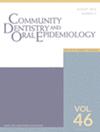Association between socioeconomic status and traumatic dental injury in permanent teeth: A systematic review with meta-analysis
Abstract
Objective
The aim of this study was to systematically review observational studies assessing the association between socioeconomic status (SES) and traumatic dental injuries (TDI) in permanent dentition.
Methods
Electronic searches were performed in PubMed, EMBASE, Web of Science, LILACS, CINAHL, COCHANE Library and ScoINDEX databases for articles published up to February 2023. Two independent reviewers performed the search and critical appraisal of the studies. The inclusion criteria were observational studies that evaluated the association between individual-level socioeconomic indicators and TDI (clinically examined) in permanent teeth. Quality assessment of included articles was conducted using the Newcastle-Ottawa Scale. Global meta-analysis was performed with all studies and different subgroup analysis based on socioeconomic indicators (household income, educational level or any other indicator), age (children, early adolescents, late adolescents or young adults) and economic classification of the country (high, upper-middle or lower-middle). A random-effects model was used to estimate pooled prevalence ratios (PR) and respective 95% confidence intervals (CI) for each study.
Results
The search strategy retrieved 11 315 publications. According to eligibility criteria, 17 articles were included in the meta-analysis. Individuals with low SES were 17% more likely to have TDI (PR 1.17; 95% CI 1.05–1.30). The subgroup analysis also revealed that the indicator (household income, PR 1.16; 95% CI 1.00–1.34) and the economic classification of the country (upper-middle, PR 1.19; 95% CI 1.07–1.33) influenced the association of SES with TDI occurrence.
Conclusions
Individuals with lower SES were more likely to present with TDI in permanent dentition than those with higher SES.

 求助内容:
求助内容: 应助结果提醒方式:
应助结果提醒方式:


